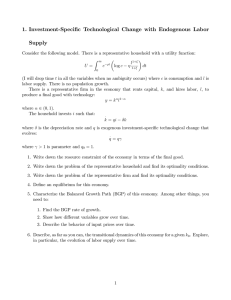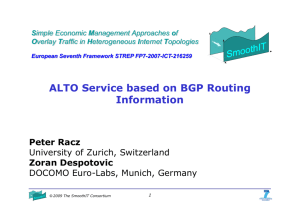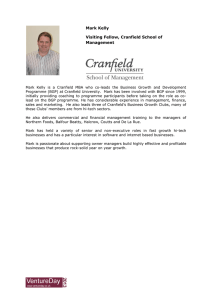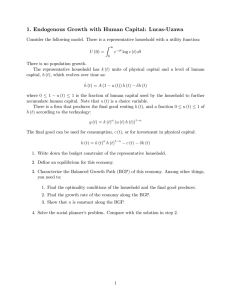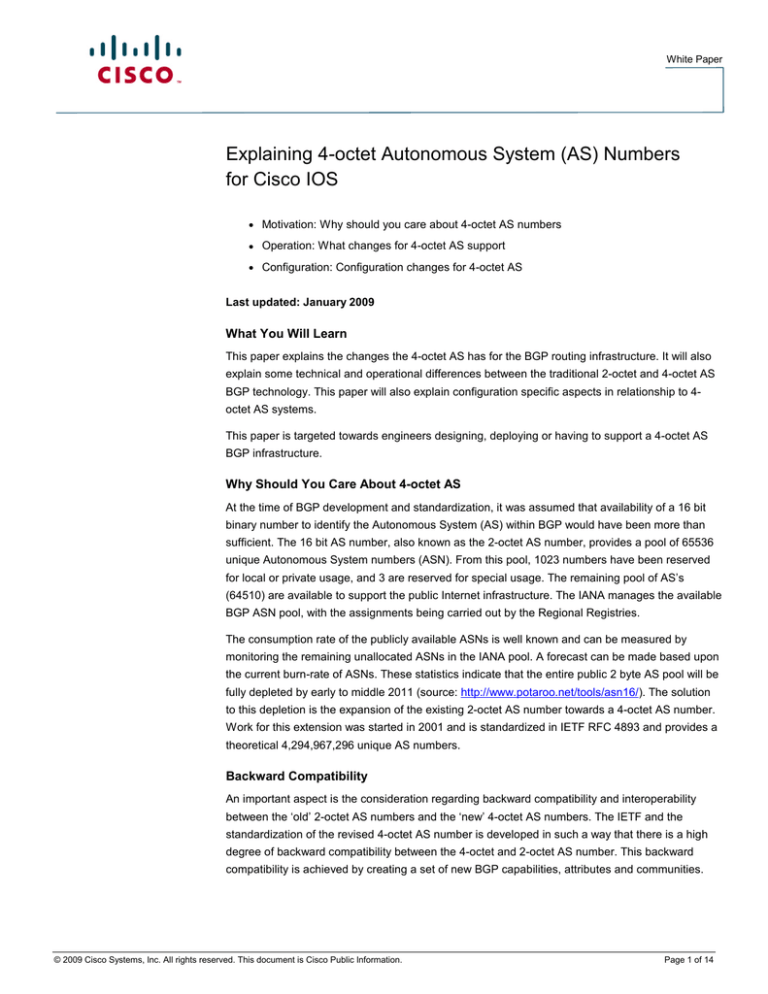
White Paper
Explaining 4-octet Autonomous System (AS) Numbers
for Cisco IOS
●
Motivation: Why should you care about 4-octet AS numbers
●
Operation: What changes for 4-octet AS support
●
Configuration: Configuration changes for 4-octet AS
Last updated: January 2009
What You Will Learn
This paper explains the changes the 4-octet AS has for the BGP routing infrastructure. It will also
explain some technical and operational differences between the traditional 2-octet and 4-octet AS
BGP technology. This paper will also explain configuration specific aspects in relationship to 4octet AS systems.
This paper is targeted towards engineers designing, deploying or having to support a 4-octet AS
BGP infrastructure.
Why Should You Care About 4-octet AS
At the time of BGP development and standardization, it was assumed that availability of a 16 bit
binary number to identify the Autonomous System (AS) within BGP would have been more than
sufficient. The 16 bit AS number, also known as the 2-octet AS number, provides a pool of 65536
unique Autonomous System numbers (ASN). From this pool, 1023 numbers have been reserved
for local or private usage, and 3 are reserved for special usage. The remaining pool of AS’s
(64510) are available to support the public Internet infrastructure. The IANA manages the available
BGP ASN pool, with the assignments being carried out by the Regional Registries.
The consumption rate of the publicly available ASNs is well known and can be measured by
monitoring the remaining unallocated ASNs in the IANA pool. A forecast can be made based upon
the current burn-rate of ASNs. These statistics indicate that the entire public 2 byte AS pool will be
fully depleted by early to middle 2011 (source: http://www.potaroo.net/tools/asn16/). The solution
to this depletion is the expansion of the existing 2-octet AS number towards a 4-octet AS number.
Work for this extension was started in 2001 and is standardized in IETF RFC 4893 and provides a
theoretical 4,294,967,296 unique AS numbers.
Backward Compatibility
An important aspect is the consideration regarding backward compatibility and interoperability
between the ‘old’ 2-octet AS numbers and the ‘new’ 4-octet AS numbers. The IETF and the
standardization of the revised 4-octet AS number is developed in such a way that there is a high
degree of backward compatibility between the 4-octet and 2-octet AS number. This backward
compatibility is achieved by creating a set of new BGP capabilities, attributes and communities.
© 2009 Cisco Systems, Inc. All rights reserved. This document is Cisco Public Information.
Page 1 of 14
White Paper
Cisco IOS Software releases supporting RFC4893 (BGP Support for Four-octet AS Number
Space) introduces the following new BGP aspects:
●
A new 4-octet BGP capability advertisement
●
New update attributes for 2-octet transit
●
New extended communities
●
AS_TRANS—A well known transition BGP AS Number ‘23456’
These new attributes, extended BGP communities and BGP capability advertisement needs
understanding when deploying routers and devices which are 4-octet AS capable. The next section
of this paper describes the operational behavior when working with BGP 4-octet AS numbers.
Operation
This paper will assume that an ‘OLD’ BGP speaker is supporting only a 2-octet AS number and
that that a BGP speaker that supports the new 4-octet AS number is as a ‘NEW’ BGP speaker.
The BGP AS number can be seen within a variety of places within the BGP protocol:
In the ‘OPEN’ message
In the AS-PATH attribute of the ‘UPDATE’ message
In the AGGREGATOR attribute of the ‘UPDATE’ message
In the EXTENDED COMMUNITY for Route-Target (RT) and SITE-OF-ORIGIN (SOO)
which are used for VPN’s
A NEW Speaker will have to support 4-octet AS values for each of the above identified messages.
For a NEW BGP speaker, the values regarding the BGP Autonomous System with the OPEN
message, the AS-PATH and AGGREGATOR attribute and the extended communities are based
upon 4-octet values, while for an OLD BGP speaker, this is based upon 2-octet values.
To support a high degree of backward compatibility between an OLD BGP speaker and a NEW
BGP speaker two additional optional transitive BGP attributes have been defined within RFC 4893:
AS4_PATH and AS4_AGGREGATOR attributes. These attributes are created and attached to
each BGP route by a NEW BGP speaker that must communicate with an OLD BGP speaker.
These are ‘optional’ attributes because these attributes may not be understood by an OLD BGP
2-octet AS BGP implementation. The ‘transitive’ character of these optional attributes means that
the attributes are forwarded by an OLD BGP speaker to all its BGP neighbors, even if the actual
2-octet AS BGP router does not understand the meaning of the attributes. More details on the why
and how this fully works will be discussed later in this paper.
One of the basic steps of the BGP protocol is to establish adjacencies between BGP peers.
Without successful completion of this step, no exchange of updates between the peers will be
possible. Successful neighbor negotiation is based upon successful completion of a TCP transport
connection, the successful processing of the BGP OPEN message and the periodic detection of
BGP keepalive messages. An important task during the neighbor establishment is the negotiation
of the BGP capabilities by each peer during the “OPEN’ message exchanges.
© 2009 Cisco Systems, Inc. All rights reserved. This document is Cisco Public Information.
Page 2 of 14
White Paper
The “OPEN” BGP message includes a set of parameters and has to be agreed upon before a full
BGP adjacency can be established. The “OPEN” BGP message is encoded as follows:
Among other capabilities, a ‘NEW’ BGP speaker uses BGP Capability Advertisements [RFC2842]
to advertise to its neighbors (either internal or external) about the support of 4-octet AS extensions.
These BGP Capability Advertisements are encoded within the ‘Optional Parameters’ of the OPEN
message. The Capability parameter contains one or more triples <Capability Code, Capability
Length, Capability Value>, where each triple is encoded as shown below:
© 2009 Cisco Systems, Inc. All rights reserved. This document is Cisco Public Information.
Page 3 of 14
White Paper
The use and meaning of these fields are as follows:
Capability Code:
Capability Code is a one octet field that unambiguously identifies individual capabilities.
IANA has assigned code ‘65’ to identify the 4-octet AS capability.
Capability Length:
Capability Length is a one octet field that contains the length of the Capability Value field
in octets. It will always be ‘0’ for the 4-octet AS capability.
Capability Value:
Capability Value is a variable length field that is interpreted according to the value of the
Capability Code field, and because there is a Capability length of ‘0’ specified, there is no
Capability Value specified or required.
Once both BGP peers have agreed upon mutual capabilities, they can start exchanging routing
information by means of BGP UPDATE messages. If we assume that both peers are ‘NEW’ BGP
speakers, then they will carry AS path information expressed in terms of 4-octet Autonomous
Systems numbers. In addition, NEW BGP speakers use the same 4-octet structure for the
AGGREGATOR attribute.
The difference between a full 4-octet AS system and a 2-octet AS system is negligible because the
BGP operation does not change at all. The only difference is that in one case the AS is 2 Bytes, it
will be in the other case, 4 Bytes. The major difference is driven by the operation principle during
transition and compatibility between 2 and 4 Byte systems. An assumed 2-to-4 Byte AS transition
constant has been that the existing 2-octet AS infrastructure must be unchanged due to potential
historical BGP implementations, and that the 4-octet BGP technology must accommodate for that
assumption. RFC4893 has succeeded for most of the deployments.
© 2009 Cisco Systems, Inc. All rights reserved. This document is Cisco Public Information.
Page 4 of 14
White Paper
Transition
When an OLD BGP speaker is peering with a NEW BGP speaker, special care needs to be taken
regarding both the BGP adjacency establishment and BGP routing loop detection. An OLD BGP
speaker has no way of understanding a 4-Octet Autonomous System number. A NEW BGP
speaker has for that purpose, four tricks available that may be used simultaneously for the sending
or receiving of BGP updates between an NEW and OLD BGP speaker. These four tricks explain
the BGP behavior during a transition scenario.
Trick #1
If the NEW BGP speaker is part of an Autonomous System which is 2-octet mappable, then it will
just send the low order 16 bits of the Autonomous System towards the peering OLD BGP speaker
within the OPEN message. A 2-octet mappable Autonomous System number is an AS number for
which the two higher order octets of the 4-octet AS number is set to zero. The 2-octet mappable
addresses are all found with the Autonomous System numbers “0 to 65536 (=2^16)”. If this
Autonomous System would be translated towards a 4-Octet binary value, then the higher order 2octet will be zero, while the lower two octets carry the full information on the Autonomous System
number, hence no information is lost.
However, if the NEW BGP speaker is part of an Autonomous System which is not 2-octet
mappable (ie: 100.200), then the NEW BGP speaker will swap the actual 4-octet Autonomous
System number with the well know Autonomous System ‘23456’, also known as AS_TRANS within
the BGP OPEN message. The impact this will have on the OLD BGP speaker is that the OLD BGP
speaker believes it is peering with Autonomous System ‘23456’ (a two byte AS) instead of the real
4-octet AS (ie: Autonomous System 100.200)
© 2009 Cisco Systems, Inc. All rights reserved. This document is Cisco Public Information.
Page 5 of 14
White Paper
Trick #2
If a NEW BGP speaker needs to send a BGP route update to an OLD BGP speaker, then the
NEW BGP speaker must make sure that his old peer can understand the information he is
sending. A crucial piece of information is the AS_PATH information attached to a BGP route. This
information is very important for AS_PATH based loop detection within the OLD BGP speaker
world. What the NEW BGP speaker will have to achieve is to translate his 4-octet AS_PATH
towards a 2-octet AS_PATH.
If a NEW BGP speaker is peering with an OLD BGP speaker, he will manipulate the 4-octet
AS_PATH to make it 2-octet compatible, which the OLD BGP speaker will understand. For each
BGP route, the new BGP speaker will either:
1.
Remove the first two octet’s of the Autonomous System number, if it was a 4-octet mappable
Autonomous System number, or
2.
The NEW BGP speaker will swap each non-mappable Autonomous System number with the
well know Autonomous System ‘23456’, also known as AS_TRANS.
© 2009 Cisco Systems, Inc. All rights reserved. This document is Cisco Public Information.
Page 6 of 14
White Paper
Trick #3
If the NEW BGP speaker has to deal with a non-mappable Autonomous System number, then in
addition to swapping this non-mappable Autonomous System number with ‘23456’, it also adds
two ‘optional transitive’ attributes AS4_PATH (Attribute number 17) and AS4_AGGREGATOR
(Attribute number 18) to the BGP route which is sent to the OLD BGP speaker. The AS4_PATH
contains the full content of the original 4-octet AS_PATH, whereas the newly created AS_PATH
has lost some information due to the conversion from 4-octet AS’s into 2-octet AS’s. The
AS4_AGGREGATOR has same context as the traditional AGGREGATOR attribute. The
AGGREGATOR attribute provides information about the last AS number that formed the
aggregated BGP route and is followed by the IP address of the BGP speaker that formed the
aggregated BGP route.
Trick #4
When a NEW BGP speaker receives an update from an OLD one, it should be prepared to receive
the AS4_PATH attribute along with the existing 2-octet AS_PATH attribute. If the AS4_PATH
attribute is also received, both the attributes will be used by the NEW BGP speaker to construct
the exact AS path information, and therefore the information carried by both the attributes will be
considered for BGP AS path loop detection within the 4-octet AS world.
It may be that a route has traversed a series of autonomous systems with 2-octet AS numbers and
OLD BGP speakers only. In that case, if the route carries the AS4_PATH attribute, this attribute
must have remained unmodified since the route left the last NEW BGP speaker. The trailing AS
path information (representing autonomous systems with 2-octet AS numbers and OLD BGP
© 2009 Cisco Systems, Inc. All rights reserved. This document is Cisco Public Information.
Page 7 of 14
White Paper
speakers only) is contained only in the current AS_PATH attribute (encoded in the leading part of
the AS_PATH attribute).
Under certain conditions, it may not be possible to reconstruct the entire AS path information from
the AS_PATH and the AS4_PATH attributes of a route. This occurs when two or more routes that
carry the AS4_PATH attribute are aggregated by an OLD BGP speaker, and the AS4_PATH
attribute of at least one of these routes carries at least one 4-octet AS number (as opposed to a
2-octet AS number that is encoded in 4 bytes). Depending on the implementation, either the
AS4_PATH attribute would be lost during route aggregation, or both the AS_PATH attribute and
the AS4_PATH attribute would contain valid, yet partial information that cannot be combined
seamlessly, resulting in incomplete AS path information in these cases.
Note that the NEW BGP speaker must also expect to receive the AS4_AGGREGATOR attribute to
make sure that the full set of information attached to a BGP route is completely valid and
contributes to the global BGP mechanism to aid BGP loop detection.
BGP Loop detection during a hybrid (OLD and NEW) BGP environment:
During a transition scenario, there will be a hybrid BGP environment due to the existence of both
NEW and OLD BGP speakers within a single network. It is crucial that BGP can perform loop
detection correctly in all situations, including a hybrid BGP environment that exists out of NEW and
OLD BGP speakers and is demonstrated by the picture below. At any time and at any location a
BGP router has sufficient information available for doing a successful AS-PATH loop detection
procedure based on the information available within the AS4-PATH and AS-PATH attributes.
© 2009 Cisco Systems, Inc. All rights reserved. This document is Cisco Public Information.
Page 8 of 14
White Paper
Extended Community Support for 4-octet Autonomous System Numbers
When a router is operating in a VPN modus, this router will be using Extended BGP Communities
to identify the VPN and to aid with VPN based routing loop detection. The two communities used in
this case are the Route-Target (RT) and Site-of-Origin (SOO) community. Originally they are
constructed as follows:
© 2009 Cisco Systems, Inc. All rights reserved. This document is Cisco Public Information.
Page 9 of 14
White Paper
As can be seen, the available data-field for the Autonomous System number is a 16 bit value.
When deploying a system supporting 4-octet Autonomous Systems numbers, this is extended
towards a 32 bit data-field. The BGP Extended Community is identified for either 2-octet or a 4octet Autonomous System by the setting of the Extended Community Type fields (Type high and
Type Low). The following values for the type fields have been standardized by IETF for RouteTarget (RT) and Site-of-Origin (SoO):
Type High
Type Low
Type of Extended Community
00
02
2-byte AS RT
00
03
2-byte AS SoO
02
02
4-byte AS RT
02
03
4-byte AS SoO
IOS Configuration
Once a Cisco router is running an IOS that has 4-octet AS support, then there is no additional
configuration required to enable 4-octet AS support for the Cisco IOS router. A few minimal
changes have been implemented for regular expressions and the representation of BGP
Autonomous System numbers. The Cisco default configuration of the 4-octet AS number is
ASPLAIN as specified in RFC5396—“Textual Representation of Autonomous System (AS)
Numbers". Changing notation between ASPLAIN and ASDOT can be made according with the
following configuration command:
router bgp 1.1
bgp asnotation dot
The following can be used to configure a 4-octet AS number on a Cisco router:
ASDOT notation:
router bgp 4.4
bgp log-neighbor-changes
neighbor 134.0.0.3 remote-as 3.3
ASPLAIN notation:
router bgp 262148
bgp log-neighbor-changes
neighbor 134.0.0.3 remote-as 196611
Also the Cisco Command Line Interface (CLI) has been enhanced for BGP CLIs to display both
2-octet and 4-octet AS path value. In case of 4-octet AS value, the value is displayed in XX.YY
format.
ASDOT notation:
R4#sh ip bgp 1.1.1.0
BGP routing table entry for 1.1.1.0/24, version 2
© 2009 Cisco Systems, Inc. All rights reserved. This document is Cisco Public Information.
Page 10 of 14
White Paper
Paths: (1 available, best #1, table default)
Flag: 0x820
Not advertised to any peer
3.3 2 1.1
134.0.0.3 from 134.0.0.3 (134.0.0.3)
Origin IGP, localpref 100, valid, external, best
R4#sh ip bgp sum
BGP router identifier 134.0.0.4, local AS number 4.4
BGP table version is 2, main routing table version 2
1 network entries using 124 bytes of memory
1 path entries using 52 bytes of memory
2/1 BGP path/bestpath attribute entries using 184 bytes of
memory
1 BGP AS-PATH entries using 40 bytes of memory
0 BGP route-map cache entries using 0 bytes of memory
0 BGP filter-list cache entries using 0 bytes of memory
BGP using 400 total bytes of memory
BGP activity 1/0 prefixes, 1/0 paths, scan interval 60 secs
Neighbor
V
134.0.0.3
4
AS MsgRcvd MsgSent
3.3
28
27
TblVer
2
InQ OutQ Up/Down
0
State/PfxRcd
0 00:25:33
1
ASPLAIN notation:
R4#sh ip bgp 1.1.1.0
BGP routing table entry for 1.1.1.0/24, version 2
Paths: (1 available, best #1, table default)
Flag: 0x820
Not advertised to any peer
196611 2 65537
134.0.0.3 from 134.0.0.3 (134.0.0.3)
Origin IGP, localpref 100, valid, external, best
R4#sh ip bgp sum
BGP router identifier 134.0.0.4, local AS number 262148
BGP table version is 2, main routing table version 2
1 network entries using 124 bytes of memory
1 path entries using 52 bytes of memory
2/1 BGP path/bestpath attribute entries using 184 bytes of
memory
© 2009 Cisco Systems, Inc. All rights reserved. This document is Cisco Public Information.
Page 11 of 14
White Paper
1 BGP AS-PATH entries using 40 bytes of memory
0 BGP route-map cache entries using 0 bytes of memory
0 BGP filter-list cache entries using 0 bytes of memory
BGP using 400 total bytes of memory
BGP activity 1/0 prefixes, 1/0 paths, scan interval 60 secs
Neighbor
V
134.0.0.3
4
AS MsgRcvd MsgSent
196611
28
TblVer
27
InQ OutQ Up/Down
2
0
State/PfxRcd
0 00:25:33
1
Redistribution between routing protocols is done for a 4-octet AS system identically the same as
for the existing 2-octet AS:
ASDOT notation:
R1(config)#router ospf 1
R1(config-router)#redistribute bgp 3.3
R3#sh ip rout | include B
Codes: L - local, C - connected, S - static, R - RIP, M - mobile, B - BGP
B
B
2.2.2.0 [20/0] via 123.0.0.2, 00:11:01
192.0.0.0/24 [20/0] via 123.0.0.2, 00:11:01
R3#sh ip route 192.0.0.0
Routing entry for 192.0.0.0/24
Known via "bgp 3.3", distance 20, metric 0
Tag 2, type external
Redistributing via ospf 1
Advertised by ospf 1
Last update from 123.0.0.2 00:12:14 ago
Routing Descriptor Blocks:
* 123.0.0.2, from 123.0.0.2, 00:11:09 ago
Route metric is 0, traffic share count is 1
AS Hops 1
Route tag 2
ASPLAIN notation:
R1(config)#router ospf 1
R1(config-router)#redistribute bgp 196611
R3#sh ip rout | include B
© 2009 Cisco Systems, Inc. All rights reserved. This document is Cisco Public Information.
Page 12 of 14
White Paper
Codes: L - local, C - connected, S - static, R - RIP, M - mobile, B BGP
B
B
2.2.2.0 [20/0] via 123.0.0.2, 00:11:01
192.0.0.0/24 [20/0] via 123.0.0.2, 00:11:01
R3#sh ip route 192.0.0.0
Routing entry for 192.0.0.0/24
Known via "bgp 196611", distance 20, metric 0
Tag 2, type external
Redistributing via ospf 1
Advertised by ospf 1
Last update from 123.0.0.2 00:12:14 ago
Routing Descriptor Blocks:
* 123.0.0.2, from 123.0.0.2, 00:11:09 ago
Route metric is 0, traffic share count is 1
AS Hops 1
Route tag 2
It is possible to configure BGP policies regarding AS_PATH filtering. A first example demonstrates
a filter for a router if you would like to receive only the routes originated from AS 1. 4 (and no
Internet routes):
ip as-path access-list 1 permit ^1\.4$
router bgp 1
neighbor 4.4.4.4 remote-as 1.4
neighbor 4.4.4.4 route-map foo in
route-map foo permit 10
match as-path 1
This ensures only networks originated from AS 1.4 are allowed into the configured router.
Important to note is the dot notation "X.Y" contains a "." which is a special character in Cisco
regular expression. To circumvent the special meaning of this, the “.” must be taken away when
using X.Y notation patterns. This is done by preceding a backslash (\) to remove the special
meaning of the "." character.
Conclusion
This paper provides a technological overview to explain why the Internet will migrate to using the
4-octet AS system; the paper also explains the working principles and provides insight on
configuration aspects of a 2/4-octet system. The Cisco IOS 4-octet Autonomous System support is
© 2009 Cisco Systems, Inc. All rights reserved. This document is Cisco Public Information.
Page 13 of 14
White Paper
fully backward compatible with the traditional 2-octet Autonomous System and provides a reliable
and proven path for your next generation Internet infrastructure.
For More Information
References used to compose this paper are:
●
Cisco IOS BGP Configuration Guide
◦
http://www.cisco.com/en/US/tech/tk365/tk80/tsd_technology_support_subprotocol_home.html
●
RFC4893—“BGP Support for Four-octet AS Number Space”
●
RFC5396—“Textual Representation of Autonomous System (AS) Numbers “
●
RFC2842—“Capabilities Advertisement with BGP-4 ”
●
16-bit AS Number Report
◦
●
ARIN, AS Number Change on 1 January 2009
◦
●
http://www.arin.net/announcements/07242008.html
RIPE NCC, AS Number change could affect Internet routing from 1 January 2009
◦
●
http://www.potaroo.net/tools/asn16/
http://www.ripe.net/news/asn-32-pr2008.html
APNIC, AS number change could affect Internet routing from 1 January 2009
◦
http://www.apnic.net/news/2008/0725.html
Printed in USA
© 2009 Cisco Systems, Inc. All rights reserved. This document is Cisco Public Information.
C11-516823-00 01/09
Page 14 of 14




